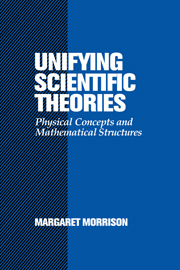Book contents
- Frontmatter
- Contents
- Acknowledgements
- Introduction
- 1 The Many Faces of Unity
- 2 Unification, Realism and Inference
- 3 Maxwell's Unification of Electromagnetism and Optics
- 4 Gauges, Symmetries and Forces: The Electroweak Unification
- 5 Special Relativity and the Unity of Physics
- 6 Darwin and Natural Selection: Unification versus Explanation
- 7 Structural Unity and the Biological Synthesis
- Conclusions
- Notes
- References
- Index
5 - Special Relativity and the Unity of Physics
Published online by Cambridge University Press: 06 October 2009
- Frontmatter
- Contents
- Acknowledgements
- Introduction
- 1 The Many Faces of Unity
- 2 Unification, Realism and Inference
- 3 Maxwell's Unification of Electromagnetism and Optics
- 4 Gauges, Symmetries and Forces: The Electroweak Unification
- 5 Special Relativity and the Unity of Physics
- 6 Darwin and Natural Selection: Unification versus Explanation
- 7 Structural Unity and the Biological Synthesis
- Conclusions
- Notes
- References
- Index
Summary
Although Maxwell's unification of electromagnetism and optics was, in most respects, an unqualified success, electricity and magnetism remained distinct forces within the framework of the theory. Despite the fact that they were integrated in a way similar to the synthesis of the electromagnetic and weak forces, it was not until Einstein's formulation of the special theory of relativity (STR) in 1905 that the two forces could be said to be truly unified. Indeed, it was that lack of theoretical unification that was responsible for the famous “asymmetries which do not appear to be inherent in the phenomena” (Einstein 1952a, p. 37), one of the key features that prompted Einstein's thoughts on relativity.
But the unification of two types of phenomena, electric and magnetic, in the STR was not, in and of itself, where the real power of the theory lay. In other words, the unity of electricity and magnetism was, in that case, indicative of something deeper and more pervasive – specifically, a unification of two domains of physics: mechanics and electrodynamics. In that sense, the STR, in particular the relativity principle, can be seen as both unifying empirical phenomena and unifying other theories; it functions as a kind of unifying meta-principle that extends to the whole of physics. As Einstein noted in his autobiographical remarks, “the universal principle of the special theory of relativity is contained in the postulate” that the laws of physics are invariant under Lorentz transformations from any inertial system to any other (1949, p. 57). Special relativity was what Einstein called a “theory of principle”, one that furnished constraints to which other theories had to adhere.
- Type
- Chapter
- Information
- Unifying Scientific TheoriesPhysical Concepts and Mathematical Structures, pp. 147 - 191Publisher: Cambridge University PressPrint publication year: 2000



